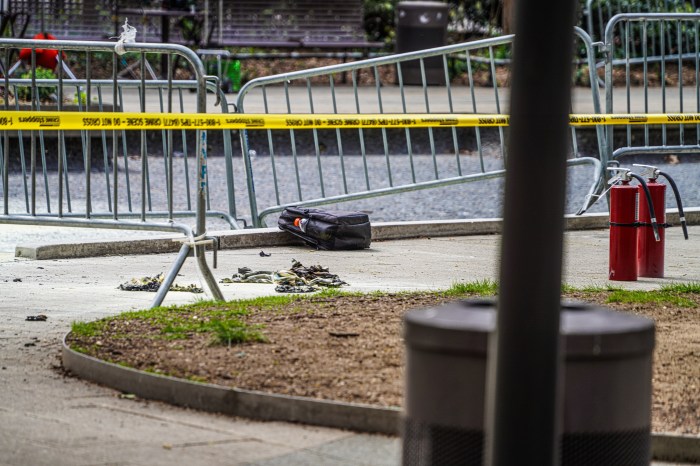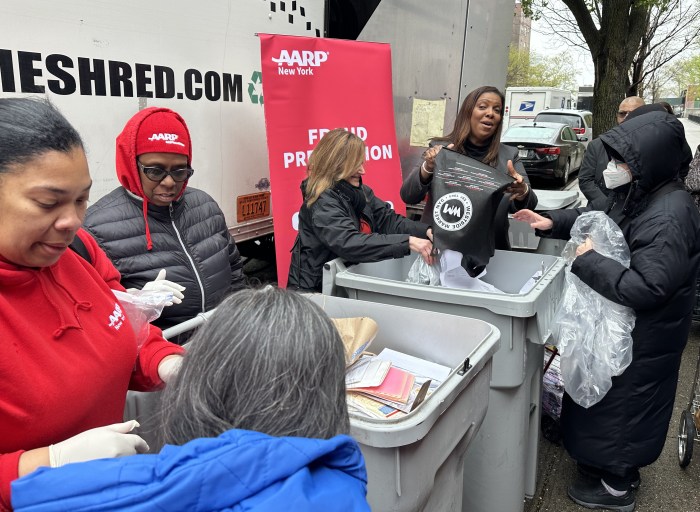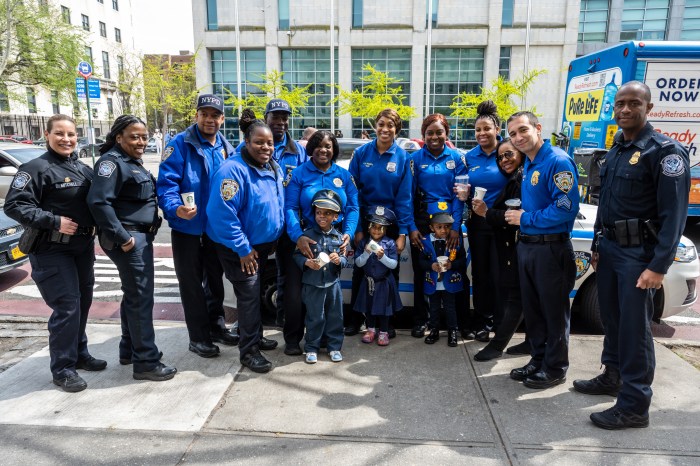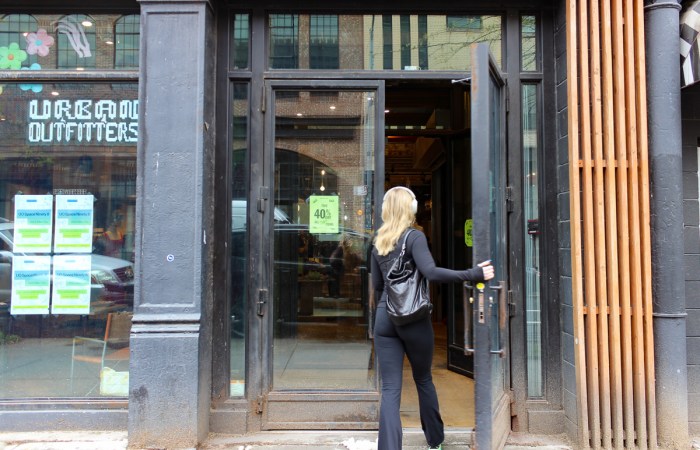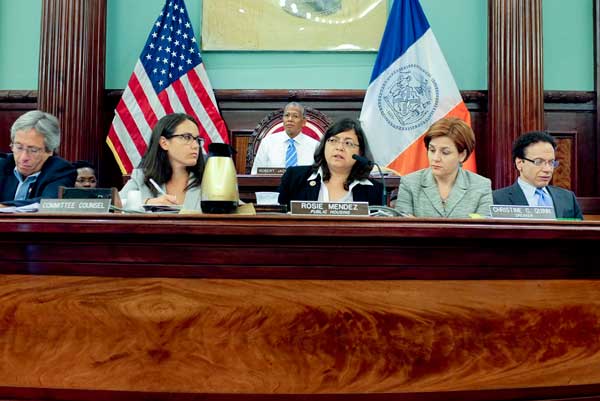
BY LINCOLN ANDERSON | Advocates turned out to testify about the shape of City Council districts covering Greenwich Village, Chinatown and the Lower East Side at the New York City Districting Commission’s first Manhattan public hearing last Thursday.
Greenwich Village political activists called for “unifying the Village district,” which is now shared by three Council districts — Districts 1, 2 and 3.
Meanwhile, an ongoing, 20-year debate continued to flare over whether to merge Chinatown and the Lower East Side to create a “minority district,” or to keep the current district lines basically intact.
The hearing was held at New York Law School, 185 West Broadway, in front of the 15 appointed members of the Districting Commission.
The commission is starting the process, which happens every 10 years, to ensure that the city’s 51 Council districts contain equal numbers of voters — around 160,000 each — and that “protected minorities” are given the chance to elect candidates of their choice.
Among those speaking in favor of a unified Village district was former City Councilmember Carol Greitzer, who represented the Village, Chelsea and part of Midtown from 1969 to ’91.
She was joined by Frieda Bradlow, a longtime political activist and a member of Village Independent Democrats club, who said she felt redistricting had been used to punish the Village for its organized resistance in the 1950s and ’60s to despised urban renewal projects.
Noting she had lived in the Charlton-King-Vandam Historic District since 1958, Bradlow said, “What I can tell you is that in those days the Village was described as going from Canal St. to 14th St. from the Hudson River to the Bowery — that makes a logical district.
“A decision was made that we were too cohesive and too well-organized — and then the split began,” Bradlow asserted. “I watched it happen to the point we are represented by three councilmembers. The cohesiveness is gone.”
Bradlow said she felt this fracturing of the traditional Village district was “retaliation” for residents having beaten back Planning Czar Robert Moses’ attempt to bulldoze and rebuild the northwest corner of the Village with an urban renewal project and also build a cross-Manhattan expressway along Broome St.
This segmentation has weakened the ability of Village activists to fight back harmful projects, she said.
“We most recently coalesced as a community against the intent of N.Y.U. expansion,” she said. “But we lost out on that one because we were represented by three different councilmembers — that doesn’t work so well.”
Bradlow urged the commission to keep in mind one of the key points on districting from the City Charter, namely, that districts should keep intact “communities of interest” — meaning neighborhoods with shared concerns.
“And that certainly is the Village,” she stated.
Jonathan Geballe, president of V.I.D., also advocated for a unified Village district.
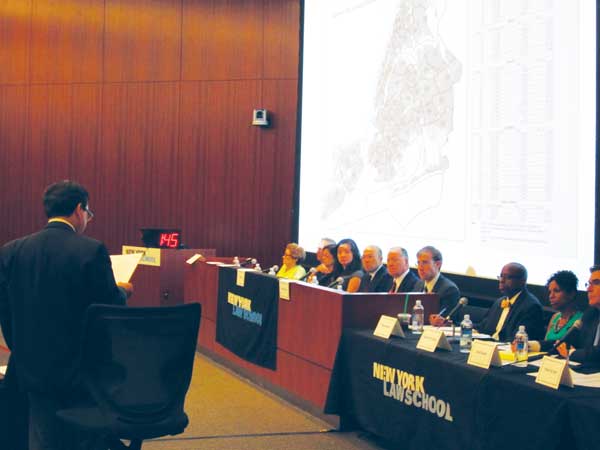
Village split 3 ways
Currently, the western portion of the Village is in District 3, represented by Christine Quinn. The northern and eastern section of the Village east of Fifth Ave. and north of Eighth St. is represented by Rosie Mendez. And Washington Square and the area south of it, plus Soho are represented by Margaret Chin.
However, activist Jim Fouratt offered an alternative idea — for a West Side district stretching from Canal St. to 50th St. west of Broadway.
“You have the theater community, you have the gay and lesbian community, you have the fashion industry, you have the digital industry,” he said of the communities of interest such a district would unite.
The Lower West Side needs effective, unified representation in the City Council, but currently lacks it, he stressed.
“We have no hospital,” he said. “We have a pipeline going in with a potential gas explosion. We have N.Y.U. gobbling up everything, and other issues that are not being addressed… .”
2 districts or 1 for Chinatown and L.E.S..?
Meanwhile, a debate that began during redistricting two decades ago continued to simmer at last Monday’s hearing, showing the ongoing split in the Chinatown and Lower East Side community over how best to shape district lines to ensure minority representation.
On one side, Margaret Fung, executive director of the Asian American Legal Defense and Education Fund, argued for creating a single district that would help ensure an Asian-American or Latino councilmember would be elected for the foreseeable future. But Chris Kui, executive director of Asian Americans for Equality, said the current district layouts are working, since there is currently a Chinese-American candidate, Chin, representing Lower Manhattan and Chinatown’s District 1, while a Latina, Mendez, is representing District 2, which includes the East Village, as well as the public housing housing projects on the Lower East Side along the East River, which have a heavy Hispanic population.
Chin used to be Kui’s deputy director at AAFE, a local housing and social services organization. Obviously, with Chin’s having won election three years ago, they feel the district lines are doing what they were intended to do: elect an Asian-American councilmember in District 1 and a Hispanic councilmember in District 2. Meanwhile, District 3, known as the “gay Council seat,” is currently represented by openly lesbian speaker Quinn, and several openly gay candidates are expected to vie for her seat next year when Quinn faces term limits and is anticipated to run for mayor.
Tracking the trends
But Fung said, at least as far as Districts 1 and 2 are concerned, the model is not sustainable if minority representation is to be continued. Due to so much development of new housing, in fact, both districts have seen a loss of minority population and an increase in white residents, which Fung said, could lead to the prospect of electing white candidates in both districts.
“That’s the future,” Fung said in a phone interview this week. “There’s going to be a lot of changes. I think it would be better to have a stronger minority district.”
Census shows changes
Currently, in District 1, the Asian voting-age population is 36 percent, while the white voting-age population, according to the 2010 Census, has grown to 46 percent.
In addition, Chinatown residents simply have more in common with Lower East Side residents — in terms of such issues as housing, fair wages, zoning and concerns about development — than they do with wealthier residents in Tribeca and Battery Park City, Fung added.
“I think it’s indisputable that Chinatown residents and Lower East Side residents have strong community interests, and that’s one of the criteria of redistricting,” she noted.
Twenty years ago, Fung said, the advocates for creating the current district lines, including AAFE, felt there should be an Asian district and a separate Latino district. However, she said, the landscape has changed, noting, “What was a 43 percent Asian population in District 1 in 1991 is now 36 percent Asian.”
And in Mendez’s District 2 — which Fung noted, “was definitely intended be the Latino-opportunity district” — the Hispanic population has also dipped, according to the Census, now standing at only 18 percent, while that district’s white population is 59 percent, Fung added.
‘Losing minority population’
“What I’m concerned about is that both districts are losing minority population,” the AALDEF director said, “and I think there’s the possibility of creating a strong minority district, and they have common concerns that would constitute a ‘community of interest.’ ”
Kui and AAFE, though, see it differently.
“Right now we have two very, very good members of the City Council who are actually Asian and Latino,” he said, referring to Chin and Mendez, “and District 3 [with] the Village and gays and lesbians…kind of connecting all minorities together. We have three progressive voices in Lower Manhattan.”
Yes, admittedly, it took 20 years to elect an Asian candidate, but it finally did happen, and things are working, he said. And District 2 has had Latino representation in its past three councilembers: Antonio Pagan, Margarita Lopez and now Mendez.
‘Fighting for 1 seat’
If, on the other hand, a new Asian-Latino district were carved out, Kui said, he could foresee negative scenarios. The first would be “Hispanics and Asians fighting against each other for one seat,” he noted.
“We have two already,” he said of Chin and Mendez. “Why create a situation where you put them against each other and have only one? We don’t want to go backwards.”
Even worse, staking everything on a single district could lead to a candidate from neither minority group winning, but a white candidate coming in and possibly taking the seat, defeating the whole idea of the district.
“Then you have nothing,” he said.
Claims Census was off
Furthermore, he disputed the recent Census figures, asserting, “There has been a lot of undercounting” of the Asian population in Chinatown. According to AAFE, many families are living doubled- or tripled-up in apartments. However, people are reluctant to be counted, because Kui said, there’s so much development going on, people fear for their homes.
“The Asian population is there — just undercounted,” he stressed. “They didn’t want to be counted because there’s so much eviction taking place.”
Chinatown has experience
What’s more, as seen with Chin’s election, Chinatown voters are more politically savvy and engaged now, according to Kui.
“There’s a lot more maturity,” he said. “We have to look at the experience and what’s on the ground, not intellectualize it.”
That newfound political maturity won’t evaporate, he assured, saying, “The current representation will continue.”
Also important, he said, AAFE simply does not endorse the idea of “separate but equal,” as he put it, that is, the creation of a low-income, minority district.
“We don’t like that idea that you concentrate all the poverty, and low-income people — all Chinatown and public housing” into a single district, Kui explained.
Bottom line, the district hasn’t changed that much since Chin was elected three years ago, so there’s no need to change things now, he stated.
As for it taking two decades to elect an Asian candidate since the 1992 redistricting, Kui framed it in the larger context of Chinatown’s historical underrepresentation. “That’s why we need to preserve the gain,” he stressed. “It’s not 20 years — it’s 160 years.”
Mendez: It works now
For her part, Mendez said she’s “all in favor of keeping the current district boundary lines. And we work well with the other district,” she noted of Chin.
Ironically, Mendez noted, 20 years ago, her political organization, CoDA (Coalition for a District Alternative), was created to advocate for an Asian-Latino district, to counter Pagan’s faction, which backed a district similar to the current lines. Both Lopez and Mendez are products of CoDA, whose candidates have now held the District 2 Council seat for close to 15 years.
‘Where does Tribeca go?’
At last week’s Districting Commission hearing, V.I.D.’ers Bradlow and Geballe both spoke in support of creating an Asian-Latino district. Geballe thought it could be achievable, while also unifying the traditional Village district, without too much difficulty.
However, after the hearing, Bradlow — while discussing her preferred solution of a unified Village district and an Asian-Latino district — did wonder aloud, “Where does Tribeca go?”
Asked what district Tribeca and Battery Park City would go into, Fung said AALDEF is still working on its maps to show how it all can be done, but hasn’t drafted anything final yet.
The Berman watch
Meanwhile, redistricting could also affect the District 3 race, specifically whether Andrew Berman, executive director of the Greenwich Village Society for Historic Preservation, decides to toss his hat in the ring versus expected candidates Corey Johnson and Yetta Kurland.
Specifically, if the N.Y.U. superblocks — where Berman has been actively fighting the university’s 2031 development plans — were redistricted out of District 1 and into District 3 it would be a major boost for a potential Berman candidacy. Add in Soho to District 3, as well, and a Berman run would look increasingly strong.
However, Kelly Magee, Chin’s spokesperson, said while District 1 did have a significant population boom in the last decade, its numbers still fall within an acceptable range for districting purposes. That is, District 1’s population of 169,225, according to the 2010 Census, is only 5.3 percent above the mean for the city’s 51 Council districts. There isn’t supposed to be more than a 10 percent population deviation between the city’s largest and smallest districts. Because District 1 falls in the middle of that spread, it wouldn’t warrant a significant redistricting, according to Magee. She said she could see Chin’s district losing a small triangular sliver along East Houston St. to District 2, but not much more than that.
The commission is slated to produce its initial district maps by Sept. 5. Another round of public hearings is scheduled for October.











